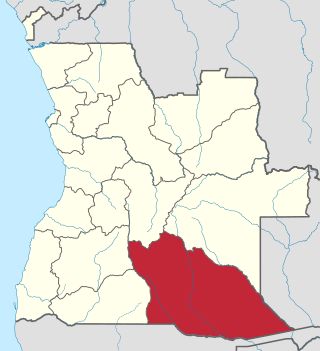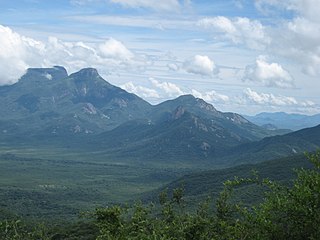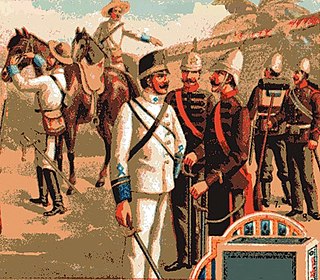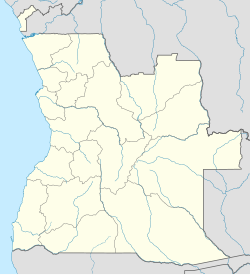
Cuando Cubango is a province of Angola and it has an area of 199,049km2 and a population of 534,002 in 2014. Menongue is the capital of the province. The governor of the province is José Martins, who was appointed governor in November 2021.

Cunene is a province of Angola. It has an area of 87,342 km2 and a population of 990,087 in 2014.

Huíla is a province of Angola. It has an area of 79,023 square kilometres (30,511 sq mi) and a population of 2,497,422. Lubango is the capital of the province. Basket-making is a significant industry in the province; many make baskets out of reeds.
Cahama is a town, with a population of 12,767, and a municipality of Cunene Province, Angola. The population of the municipality was 70,061 according to the 2014 census in an area of 9,700 km2. The municipality consists of the communes Cahama and Otchinjau. There is an airport (FN17) to the north of the town.
Ondjiva, formerly Vila Pereira d'Eça, is a town, with a population of 121,537 (2014), and a commune in the municipality of Cuanhama, province of Cunene, Angola. It is also the administrative capital of Cunene Province and is located at the extreme south of the country, about 42 kilometres (26 mi) from the border with Namibia. It was traditionally the seat of the Ovambo king of the Oukwanyama tribe. Ondjiva was greatly affected by the Angolan Civil War (1975-2002).

Xangongo is a town, with a population of 35,000 (2014), and a commune in the municipality of Ombadja, province of Cunene, Angola.
Naulila is a town and commune in the municipality of Ombadja, province of Cunene, Angola.

The tourism industry in Angola is based on the country's natural environment, including its rivers, waterfalls and coastline. Angola's tourism industry is relatively new, as much of the country was ravaged during the post-colonial civil war which ended in 2002. Unlike most countries in the region, which generally give US, EU, and many other citizens a visa on arrival or require no visa at all, Angola has complicated visa requirements. This procedure towards visitors places the country at a disadvantage in the competitive international tourism market.
Cuvelai is a town and municipality in Cunene Province in Angola. The municipality had a population of 57,398 in 2014.
Namacunde or Namakunde is a town and municipality in Cunene Province in Angola. The municipality had a population of 142,047 in 2014.
Curoca or Kuroka is a municipality in Cunene Province in Angola. The municipality had a population of 41,087 in 2014. It used to be called Vila de Aviz.
Lutheranism was first introduced to Angola in the late 1800s, when Finnish missionaries began working in northern Namibia and southern Angola. Following the Portuguese defeat of Mandume Ya Ndemufayo in 1917, the Lutheran church in Angola was repressed by the Roman Catholic Portuguese authorities. In 1956, Lutheranism was reestablished in Angola, and in 1991, the Evangelical Lutheran Church of Angola was organized as an independent church body. In 1997, a smaller group of conservative Lutheran missionaries helped to organize a second Angolan Lutheran church: the Confessional Lutheran Church in Angola.

Humbe is a town and commune in the municipality of Ombadja, province of Cunene, Angola.

In the Battle of the Cunene River, Portuguese Colonial forces were defeated by Angolan Ovambo warriors on 25 September 1904. The defeat was one of the heaviest defeats in Portuguese Colonial history since Alcácer Quibir (1578) and is comparable to the British defeat at Isandhlwana against the Zulus (1879), the Italian defeats at Dogali (1887) and at Adwa (1896) against the Ethiopians or the Spanish defeats at Melilla (1909) and at Annual (1921) against the Rif.

Ombadja is municipality in Cunene Province, Angola. Its seat is the village of Xangongo. It occupies 12,264 square kilometers and has about 304,964 inhabitants as of the 2014 Angolan census. It is bordered to the north by the municipality of Matala, in the east by the municipalities of Cuvelai, Namacunde, Cuanhama, west by the municipalities of Curoca and Cahama. It contains the communes of Xangongo, Ombala-Yo-Mungo, Naulila, Humbe and Mucope.
Nehone is a town and commune of Angola, located in the province of Cunene.
Evale is a town and commune of Angola, located in the province of Cunene.
Môngua is a town and commune of Angola, located in the province of Cunene.
Mukolongodjo is a town and commune of Angola, located in the province of Cunene.
Augusto e Kafelango Comercial FC best known as AKC is an Angolan sports club from the city of Ondjiva, Cunene province.







